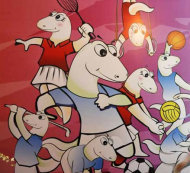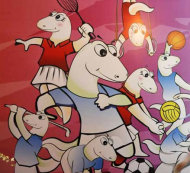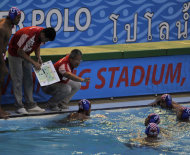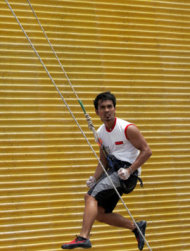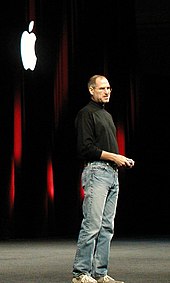Steven Paul Jobs (
/ˈdʒɒbz/; February 24, 1955 – October 5, 2011) was an American businessman and inventor
[5] [6] widely recognized (along with his Apple business partner
Steve Wozniak) as a charismatic pioneer of the
personal computer revolution. He was co-founder, chairman, and chief executive officer of
Apple Inc. Jobs was co-founder and previously served as chief executive of
Pixar Animation Studios; he became a member of the board of directors of
the Walt Disney Company in 2006, following the acquisition of Pixar by Disney.
In the late 1970s, Apple co-founder
Steve Wozniak engineered one of the first commercially successful lines of personal computers, the
Apple II series. Jobs directed its aesthetic design and marketing along with
A.C. "Mike" Markkula, Jr. and others.
In the early 1980s, Jobs was among the first to see the commercial potential of
Xerox PARC's
mouse-driven
graphical user interface, which led to the creation of the
Apple Lisa (engineered by Ken Rothmuller and
John Couch) and, one year later, of Apple employee
Jef Raskin's
Macintosh. After losing a power struggle with the board of directors in 1985, Jobs left Apple and founded
NeXT, a
computer platform development company specializing in the higher-education and business markets.
In 1986, he acquired the computer graphics division of
Lucasfilm Ltd, which was spun off as
Pixar Animation Studios.
[7] He was credited in
Toy Story (1995) as an executive producer. He remained
CEO and majority shareholder at 50.1 percent until its acquisition by
The Walt Disney Company in 2006,
[8] making Jobs Disney's largest individual shareholder at seven percent and a member of Disney's Board of Directors.
[9][10]
Apple's 1996 buyout of NeXT brought Jobs back to the company he
co-founded, and he served as its interim CEO from 1997, then becoming
permanent CEO from 2000, onwards, spearheading the advent of the
iMac,
iTunes,
iPod,
iPhone, and
iPad.
[11] In buying NeXT, Apple also "acquire[d] the operating system that became
Mac OS X."
[12] From 2003, Jobs fought an eight-year battle with cancer,
[13]
and eventually resigned as CEO in August 2011, while on his third
medical leave. He was then elected chairman of Apple's board of
directors.
On October 5, 2011, around 3:00 p.m., Jobs died at his home in
Palo Alto, California, aged 56, six weeks after resigning as CEO of Apple. A copy of his death certificate indicated
respiratory arrest as the immediate cause of death, with "
metastatic pancreas neuroendocrine tumor" as the underlying cause. His occupation was listed as "entrepreneur" in the "high tech" business.
[14]
Early life and education
In 1974, Jobs took a job as a technician at
Atari, Inc. in
Los Gatos, California.
[22] He traveled to
India in the summer of 1974
[23] to visit
Neem Karoli Baba[24] at his Kainchi Ashram with a Reed College friend (and, later, an early Apple employee),
Daniel Kottke,
in search of spiritual enlightenment. However, when they got to the
Neem Karoli ashram, it was basically deserted after Neem Karoli had died
earlier in the year.
[22] Then they made a long trek up a huge dry riverbed to an ashram of
Hariakhan Baba. In India, they spent a lot of time on endless bus rides from
Delhi to
Uttar Pradesh and back, then up to
Himachal Pradesh and back.
[22]
Jobs left India after staying for seven months
[25] and returned to the US ahead of
Daniel Kottke,
[22] with his head shaved and wearing traditional Indian clothing.
[26][27] During this time, Jobs experimented with
psychedelics, calling his
LSD experiences "one of the two or three most important things [he had] done in [his] life".
[28] He later said that people around him who did not share his
countercultural roots could not fully relate to his thinking.
[28]
Jobs returned to Atari and was assigned to create a
circuit board for the game
Breakout. According to Atari co-founder
Nolan Bushnell,
Atari offered $100 for each chip that was eliminated in the machine.
Jobs had little interest in or knowledge of circuit board design and
made a deal with Wozniak to split the fee evenly between them if Wozniak
could minimize the number of chips. Much to the amazement of Atari,
Wozniak reduced the number of chips by 50, a design so tight that it was
impossible to reproduce on an assembly line. According to Wozniak, Jobs
told Wozniak that Atari gave them only $700 (instead of the offered
$5,000) and that Wozniak's share was thus $350.
[29]
Wozniak didn't learn about the bonus until about ten years later, but
said that had Jobs told him about it and said he needed the money,
Wozniak would have given it to him.
[30]
Jobs began attending meetings of the
Homebrew Computer Club with Wozniak in 1975.
[2] He greatly admired
Edwin H. Land, the inventor of instant photography and founder of
Polaroid Corporation, and explicitly modeled his career after him.
[31][32]
Career
Apple Computer
obs and
Steve Wozniak
met in 1971, when their mutual friend, Bill Fernandez, introduced
21-year-old Wozniak to 16-year-old Jobs. In 1976, Woz invented the
Apple I computer. Jobs, Wozniak, and
Ronald Wayne founded Apple computer in the garage of Jobs's parents in order to sell it.
[33] They received funding from a then-semi-retired Intel product-marketing manager and engineer
A.C. "Mike" Markkula, Jr.[34] As Apple continued to expand with Wozniak's next version, the
Apple II, the company began looking for an experienced executive to help manage its expansion.
In 1978, Apple recruited
Mike Scott from
National Semiconductor to serve as CEO for what turned out to be several turbulent years. In 1983, Jobs lured
John Sculley away from
Pepsi-Cola
to serve as Apple's CEO, asking, "Do you want to sell sugar water for
the rest of your life, or do you want to come with me and change the
world?"
[35] Apple president
Mike Markkula
also wanted to retire and believed that Jobs lacked the discipline and
temperament needed to run Apple on a daily basis and that Sculley's
conventional business background and recent successes would give a more
favorable image.
[citation needed]
In the early 1980s, Jobs was among the first to see the commercial potential of
Xerox PARC's mouse-driven
graphical user interface, which led to the creation of the
Apple Lisa. One year later, Apple employee
Jef Raskin invented the
Macintosh.
[36][37]
The following year, Apple aired a
Super Bowl television commercial titled "
1984". At Apple's annual shareholders meeting on January 24, 1984, an emotional Jobs introduced the
Macintosh to a wildly enthusiastic audience;
Andy Hertzfeld described the scene as "pandemonium".
[38] The Macintosh became the first commercially successful small computer with a
graphical user interface.
While Jobs was a persuasive and charismatic director for Apple, some
of his employees from that time described him as an erratic and
temperamental manager. An industry-wide sales slump towards the end of
1984 caused a deterioration in Jobs's working relationship with Sculley,
as well as layoffs and disappointing sales performance. An internal
power struggle developed between Jobs and Sculley.
[39] Jobs kept meetings running past midnight, sent out lengthy faxes, then called new meetings at 7:00 am.
[40]
The Apple board of directors instructed Sculley to "contain" Jobs and
limit his ability to launch expensive forays into untested products.
[citation needed]
Sculley learned that Jobs—believing Sculley to be "bad for Apple" and
the wrong person to lead the company—had been attempting to organize a
boardroom coup,
[39] and on May 24, 1985,
[39]
he called a board meeting to resolve the matter. Apple's board of
directors sided with Sculley and removed Jobs from his managerial duties
as head of the Macintosh division.
[41][42] Jobs resigned from Apple five months later
[39] and founded
NeXT Inc. the same year.
[40][43]
In a speech Jobs gave at Stanford University in 2005, he said being
fired from Apple was the best thing that could have happened to him;
"The heaviness of being successful was replaced by the lightness of
being a beginner again, less sure about everything. It freed me to enter
one of the most creative periods of my life." And he added, "I'm pretty
sure none of this would have happened if I hadn't been fired from
Apple. It was awful-tasting medicine, but I guess the patient needed
it."
[21][44][45]
NeXT Computer
After leaving Apple, Jobs founded
NeXT Computer
in 1985, with $7 million. A year later, Jobs was running out of money,
and with no product on the horizon, he appealed for venture capital.
Eventually, he attracted the attention of billionaire
Ross Perot who invested heavily in the company.
[46] NeXT workstations were first released in 1990, priced at $9,999. Like the
Apple Lisa,
the NeXT workstation was technologically advanced, but was largely
dismissed as cost-prohibitive by the educational sector for which it was
designed.
[47] The NeXT workstation was known for its technical strengths, chief among them its
object-oriented
software development system. Jobs marketed NeXT products to the
financial, scientific, and academic community, highlighting its
innovative, experimental new technologies, such as the
Mach kernel, the
digital signal processor chip, and the built-in
Ethernet port.
Tim Berners-Lee invented the
World Wide Web on a NeXT computer at
CERN.
[48]
The revised, second-generation
NeXTcube
was released in 1990, also. Jobs touted it as the first "interpersonal"
computer that would replace the personal computer. With its innovative
NeXTMail
multimedia email system, NeXTcube could share voice, image, graphics,
and video in email for the first time. "Interpersonal computing is going
to revolutionise human communications and groupwork", Jobs told
reporters.
[49]
Jobs ran NeXT with an obsession for aesthetic perfection, as evidenced
by the development of and attention to NeXTcube's magnesium case.
[50]
This put considerable strain on NeXT's hardware division, and in 1993,
after having sold only 50,000 machines, NeXT transitioned fully to
software development with the release of
NeXTSTEP/
Intel.
[51] The company reported its first profit of $1.03 million in 1994.
[46] In 1996, NeXT Software, Inc. released
WebObjects,
a framework for Web application development. After NeXT was acquired by
Apple Inc. in 1997, WebObjects was used to build and run the
Apple Store,
[51] MobileMe services, and the
iTunes Store.
Pixar and Disney
In 1986, Jobs bought The Graphics Group (later renamed
Pixar) from
Lucasfilm's computer graphics division for the price of $10 million, $5 million of which was given to the company as capital.
[52]
The new company, which was originally based at
Lucasfilm's Kerner Studios in
San Rafael, California, but has since relocated to
Emeryville, was initially intended to be a high-end graphics hardware developer. After years of unprofitability selling the
Pixar Image Computer, it contracted with Disney to produce a number of computer-animated feature films that Disney would co-finance and distribute.
[citation needed]
The first film produced by the partnership,
Toy Story, with Jobs credited as executive producer,
[53]
brought fame and critical acclaim to the studio when it was released in
1995. Over the next 15 years, under Pixar's creative chief
John Lasseter, the company produced box-office hits
A Bug's Life (1998);
Toy Story 2 (1999);
Monsters, Inc. (2001);
Finding Nemo (2003);
The Incredibles (2004);
Cars (2006);
Ratatouille (2007);
WALL-E (2008);
Up (2009); and
Toy Story 3 (2010).
Finding Nemo,
The Incredibles,
Ratatouille,
WALL-E,
Up and
Toy Story 3 each received the
Academy Award for Best Animated Feature, an award introduced in 2001.
[citation needed]
n the years 2003 and 2004, as Pixar's contract with Disney was running out, Jobs and Disney chief executive
Michael Eisner tried but failed to negotiate a new partnership,
[55]
and in early 2004, Jobs announced that Pixar would seek a new partner
to distribute its films after its contract with Disney expired.
In October 2005,
Bob Iger
replaced Eisner at Disney, and Iger quickly worked to patch up
relations with Jobs and Pixar. On January 24, 2006, Jobs and Iger
announced that Disney had agreed to purchase Pixar in an all-stock
transaction worth $7.4 billion. When the deal closed, Jobs became
The Walt Disney Company's largest single shareholder with approximately seven percent of the company's stock.
[9] Jobs's holdings in Disney far exceeded those of Eisner, who holds 1.7 percent, and of Disney family member
Roy E. Disney,
who until his 2009 death held about one percent of the company's stock
and whose criticisms of Eisner — especially that he soured Disney's
relationship with Pixar — accelerated Eisner's ousting. Jobs joined the
company's board of directors upon completion of the merger and also
helped oversee Disney and Pixar's combined animation businesses with a
seat on a special six-person steering committee.
[citation needed]
Return to Apple
In 1996, Apple announced that it would buy
NeXT for $429 million. The deal was finalized in late 1996,
[56] bringing Jobs back to the company he co-founded. Jobs became
de facto chief after then-CEO
Gil Amelio was ousted in July 1997. He was formally named interim chief executive in September.
[57] In March 1998, to concentrate Apple's efforts on returning to profitability, Jobs terminated a number of projects, such as
Newton,
Cyberdog, and
OpenDoc.
In the coming months, many employees developed a fear of encountering
Jobs while riding in the elevator, "afraid that they might not have a
job when the doors opened. The reality was that Jobs's summary
executions were rare, but a handful of victims was enough to terrorize a
whole company."
[58] Jobs also changed the licensing program for
Macintosh clones, making it too costly for the manufacturers to continue making machines.
With the purchase of NeXT, much of the company's technology found its way into Apple products, most notably
NeXTSTEP, which evolved into
Mac OS X. Under Jobs's guidance, the company increased sales significantly with the introduction of the
iMac
and other new products; since then, appealing designs and powerful
branding have worked well for Apple. At the 2000 Macworld Expo, Jobs
officially dropped the "interim" modifier from his title at Apple and
became permanent CEO.
[59] Jobs quipped at the time that he would be using the title "iCEO".
[60]
The company subsequently branched out, introducing and improving upon other digital appliances. With the introduction of the
iPod portable music player, iTunes digital music software, and the
iTunes Store,
the company made forays into consumer electronics and music
distribution. On June 29, 2007, Apple entered the cellular phone
business with the introduction of the
iPhone, a
multi-touch
display cell phone, which also included the features of an iPod and,
with its own mobile browser, revolutionized the mobile browsing scene.
While stimulating innovation, Jobs also reminded his employees that
"real artists ship".
[61]
Jobs was both admired and criticized for his consummate skill at persuasion and salesmanship, which has been dubbed the "
reality distortion field" and was particularly evident during his keynote speeches (colloquially known as "
Stevenotes") at
Macworld Expos and at
Apple Worldwide Developers Conferences. In 2005, Jobs responded to criticism of Apple's poor recycling programs for
e-waste
in the US by lashing out at environmental and other advocates at
Apple's Annual Meeting in Cupertino in April. A few weeks later, Apple
announced it would take back iPods for free at its retail stores. The
Computer TakeBack Campaign responded by flying a banner from a plane over the Stanford University graduation at which Jobs was the commencement speaker.
[21] The banner read "Steve, don't be a mini-player—recycle all e-waste".
In 2006, he further expanded Apple's recycling programs to any US
customer who buys a new Mac. This program includes shipping and
"environmentally friendly disposal" of their old systems.
[62]
Resignation
In August 2011, Jobs resigned as CEO of Apple, but remained with the company as chairman of the company's board.
[63][64] Hours after the announcement, Apple Inc. (AAPL) shares dropped five percent in after-hours trading.
[65]
This relatively small drop, when considering the importance of Jobs to
Apple, was associated with the fact that his health had been in the news
for several years, and he had been on medical leave since January 2011.
[66] It was believed, according to
Forbes, that the impact would be felt in a negative way beyond Apple, including at
The Walt Disney Company where Jobs served as director.
[67] In after-hours trading on the day of the announcement, Walt Disney Co. (DIS) shares dropped 1.5 percent.
[68]
Wealth
Jobs
earned only $1 a year as CEO of Apple,
[69]
but held 5.426 million Apple shares, as well as 138 million shares in
Disney (which he received in exchange for Disney's acquisition of
Pixar).
[70]
Jobs quipped that the $1 per annum he was paid by Apple was based on
attending one meeting for 50 cents while the other 50 cents was based on
his performance.
[71] Forbes estimated his net wealth at $8.3 billion in 2010, making him the 42nd wealthiest American.
[72]
Stock options backdating issue
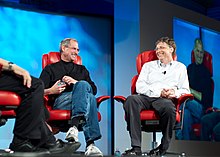
Steve Jobs and
Bill Gates at the fifth
D: All Things Digital conference (
D5) in 2007
In 2001, Jobs was granted stock options in the amount of 7.5 million
shares of Apple with an exercise price of $18.30. It was alleged that
the options had been
backdated,
and that the exercise price should have been $21.10. It was further
alleged that Jobs had thereby incurred taxable income of $20,000,000
that he did not report, and that Apple overstated its earnings by that
same amount. As a result, Jobs potentially faced a number of criminal
charges and civil penalties. The case was the subject of active criminal
and civil government investigations,
[73]
though an independent internal Apple investigation completed on
December 29, 2006, found that Jobs was unaware of these issues and that
the options granted to him were returned without being exercised in
2003.
[74]
On July 1, 2008, a $7-billion class action suit was filed against
several members of the Apple Board of Directors for revenue lost due to
the alleged securities fraud.
[75][76]
Management style
Jobs was a demanding perfectionist
[77][78]
who always aspired to position his businesses and their products at the
forefront of the information technology industry by foreseeing and
setting trends, at least in innovation and style.
He summed up that self-concept at the end of his keynote speech at the
Macworld Conference and Expo in January 2007, by quoting ice hockey player
Wayne Gretzky:
There's an old Wayne Gretzky quote that I love. 'I skate to where the
puck is going to be, not where it has been.' And we've always tried to
do that at Apple. Since the very very beginning. And we always will.[79]
Much was made of Jobs's aggressive and demanding personality.
Fortune wrote that he was "considered one of Silicon Valley's leading
egomaniacs".
[80] Commentaries on his temperamental style can be found in
Michael Moritz's
The Little Kingdom,
The Second Coming of Steve Jobs, by Alan Deutschman; and
iCon: Steve Jobs, by Jeffrey S. Young & William L. Simon. In 1993, Jobs made
Fortune's list of America's Toughest Bosses in regard to his leadership of NeXT.
NeXT Cofounder Dan'l Lewin was quoted in
Fortune as saying of
that period, "The highs were unbelievable ... But the lows were
unimaginable", to which Jobs's office replied that his personality had
changed since then.
[81]
In 2005, Jobs banned all books published by
John Wiley & Sons from
Apple Stores in response to their publishing an unauthorized biography,
iCon: Steve Jobs.
[82] In its 2010 annual earnings report, Wiley said it had "closed a deal ... to make its titles available for the iPad."
[83] Jef Raskin,
a former colleague, once said that Jobs "would have made an excellent
king of France", alluding to Jobs's compelling and larger-than-life
persona.
[84] Floyd Norman said that at Pixar, Jobs was a "mature, mellow individual" and never interfered with the creative process of the filmmakers.
[85]
Jobs had a public war of words with
Dell Computer CEO
Michael Dell, starting
[when?] when Jobs first criticized Dell for making "un-innovative beige boxes".
[86] On October 6, 1997, in a
Gartner
Symposium, when Michael Dell was asked what he would do if he owned
then-troubled Apple Computer, he said "I'd shut it down and give the
money back to the shareholders."
[87] In 2006, Jobs sent an email to all employees when Apple's
market capitalization rose above Dell's. The email read:
Team, it turned out that Michael Dell wasn't perfect at predicting
the future. Based on today's stock market close, Apple is worth more
than Dell. Stocks go up and down, and things may be different tomorrow,
but I thought it was worth a moment of reflection today. Steve.[88]
Inventions and designs
His design sense was greatly influenced by the Buddhism which he experienced in India while on a seven-month spiritual journey.
[89] His sense of intuition was also influenced by the spiritual people with whom he studied.
[89]
As of October 9, 2011
(2011 -10-09)[update],
Jobs is listed as either primary inventor or co-inventor in 342 United
States patents or patent applications related to a range of technologies
from actual computer and portable devices to user interfaces (including
touch-based), speakers, keyboards, power adapters, staircases, clasps,
sleeves,
lanyards and packages. Most of these are design patents (specific product designs) as opposed to utility patents (inventions).
[90][91] He has 43 issued US patents on inventions.
[92] The patent on the Mac OS X
Dock user interface with "magnification" feature was issued the day before he died.
[93]
Philanthropy
Arik Hesseldahl of
BusinessWeek magazine stated that "Jobs isn't widely known for his association with philanthropic causes", compared to
Bill Gates's efforts.
[94] Jobs said he does charitable acts privately.
[95] After resuming control of Apple in 1997, Jobs eliminated all corporate philanthropy programs initially.
[96] Later, under Jobs, Apple signed to participate in
Product Red
program, producing red versions of devices to give profits from sales
to charity. Apple became the single largest contributor since then. The
chief of the Product Red project, singer
Bono
cited Jobs saying there was "nothing better than the chance to save
lives," when he initially approached Apple with the invitation to
participate in the program.
[97]
Personal life
Jobs's birth parents met at the
University of Wisconsin. Abdulfattah "John" Jandali, a
Syrian Muslim,
[98]
taught there. Joanne Carole Schieble was his student; however, they
were the same age because Jandali had "gotten his PhD really young."
[99][100][101] Schieble had a career as a
speech language pathologist. Jandali taught political science at the
University of Nevada[disambiguation needed  ]
]
in the 1960s, and then made his career in the food and beverage
industry, and since 2006, has been a vice president at a casino in
Reno, Nevada.
[102][103]
In December 1955, ten months after giving up their baby boy, Schieble
and Jandali married. In 1957, they had a daughter Mona together. They
divorced in 1962, and Jandali lost touch with his daughter.
[104] Her mother remarried and had Mona take the surname of her stepfather, so she became known as
Mona Simpson.
[100]
In the 1980s, Jobs found his birth mother, Joanne Schieble Simpson,
who told him he had a biological sister, Mona Simpson. They met for the
first time in 1985
[104]
and became close friends. The siblings kept their relationship secret
until 1986, when Mona introduced him at a party for her first book.
[16]
After deciding to search for their father, Simpson found Jandali
managing a coffee shop. Without knowing who his son had become, Jandali
told Mona that he had previously managed a popular restaurant in the
Silicon Valley where "Even Steve Jobs used to eat there. Yeah, he was a
great tipper." In a taped interview with his biographer
Walter Isaacson, aired on
60 Minutes,
[105]
Jobs said: "When I was looking for my biological mother, obviously, you
know, I was looking for my biological father at the same time, and I
learned a little bit about him and I didn't like what I learned. I asked
her to not tell him that we ever met...not tell him anything about me."
[106] Jobs was in occasional touch with his mother Joanne Simpson,
[96][107] who lives in a nursing home in Los Angeles.
[100]
When speaking about his biological parents, Jobs stated: "They were my
sperm and egg bank. That's not harsh, it's just the way it was, a sperm
bank thing, nothing more."
[17] Jandali stated in an interview with the
The Sun
in August 2011, that his efforts to contact Jobs were unsuccessful.
Jandali mailed in his medical history after Jobs's pancreatic disorder
was made public that year.
[108][109][110]
In her
eulogy to Jobs at his memorial service, Mona Simpson stated:
- I grew up as an only child, with a single mother. Because we were
poor and because I knew my father had emigrated from Syria, I imagined
he looked like Omar Sharif. I hoped he would be rich and kind and would
come into our lives (and our not yet furnished apartment) and help us.
Later, after I'd met my father, I tried to believe he'd changed his
number and left no forwarding address because he was an idealistic
revolutionary, plotting a new world for the Arab people. Even as a
feminist, my whole life I'd been waiting for a man to love, who could
love me. For decades, I'd thought that man would be my father. When I
was 25, I met that man and he was my brother.[104]
Jobs's first child,
Lisa Brennan-Jobs, was born in 1978, the daughter of his longtime partner Chris Ann Brennan, a Bay Area painter.
[96]
For two years, she raised their daughter on welfare while Jobs denied
paternity by claiming he was sterile; he later acknowledged Lisa as his
daughter.
[96] Jobs later married
Laurene Powell on March 18, 1991, in a ceremony at the
Ahwahnee Hotel in
Yosemite National Park. Presiding over the wedding was
Kobun Chino Otogawa, a
Zen Buddhist monk. Their son, Reed, was born September 1991, followed by daughters Erin in August 1995, and Eve in 1998.
[111] The family lives in
Palo Alto, California.
[112]
In the unauthorized biography,
The Second Coming of Steve Jobs, author Alan Deutschman reports that Jobs once dated
Joan Baez.
Deutschman quotes Elizabeth Holmes, a friend of Jobs from his time at
Reed College, as saying she "believed that Steve became the lover of
Joan Baez in large measure because Baez had been the lover of
Bob Dylan" (Dylan was the Apple icon's favorite musician). In another unauthorized biography,
iCon: Steve Jobs
by Jeffrey S. Young & William L. Simon, the authors suggest that
Jobs might have married Baez, but her age at the time (41) meant it was
unlikely the couple could have children.
Jobs was also a fan of
The Beatles. He referred to them on multiple occasions at Keynotes and also was interviewed on a showing of a
Paul McCartney concert. When asked about his
business model on
60 Minutes, he replied:
My model for business is The Beatles: They were four guys that kept
each other's negative tendencies in check; they balanced each other. And
the total was greater than the sum of the parts. Great things in
business are never done by one person, they are done by a team of
people.[113]
In 1982, Jobs bought an apartment in
The San Remo, an apartment building in New York City with a politically progressive reputation, where
Demi Moore,
Steven Spielberg,
Steve Martin, and Princess
Yasmin Aga Khan, daughter of
Rita Hayworth, also had apartments. With the help of
I.M. Pei,
Jobs spent years renovating his apartment in the top two floors of the
building's north tower, only to sell it almost two decades later to
U2 singer
Bono. Jobs never moved in.
[114][115]
In 1984, Jobs purchased the
Jackling House, a 17,000-square-foot (1,600 m
2), 14-bedroom
Spanish Colonial mansion designed by
George Washington Smith in
Woodside, California.
Although it reportedly remained in an almost unfurnished state, Jobs
lived in the mansion for almost ten years. According to reports, he kept
a 1966
BMW R60/2 motorcycle in the living room, and let
Bill Clinton
use it in 1998. From the early 1990s, Jobs lived in a house in the Old
Palo Alto neighborhood of Palo Alto. President Clinton dined with Jobs
and 14 Silicon Valley CEOs there on August 7, 1996, at a meal catered by
Greens Restaurant.
[116][117] Clinton returned the favor and Jobs, who was a
Democratic donor, slept in the Lincoln bedroom of the
White House.
[118]
Jobs allowed Jackling House to fall into a state of disrepair,
planning to demolish the house and build a smaller home on the property;
but he met with complaints from local preservationists over his plans.
In June 2004, the Woodside Town Council gave Jobs approval to demolish
the mansion, on the condition that he advertise the property for a year
to see if someone would move it to another location and restore it. A
number of people expressed interest, including several with experience
in restoring old property, but no agreements to that effect were
reached. Later that same year, a local preservationist group began
seeking legal action to prevent demolition. In January 2007, Jobs was
denied the right to demolish the property, by a court decision.
[119] The court decision was overturned on appeal in March 2010, and the mansion was demolished beginning February 2011.
[120]
Jobs usually wore a black long-sleeved
mock turtleneck made by
Issey Miyake (that was sometimes reported to be made by
St. Croix),
Levi's 501 blue jeans, and
New Balance 991 sneakers.
[121][122]
Jobs told Walter Isaacson "...he came to like the idea of having a
uniform for himself, both because of its daily convenience (the
rationale he claimed) and its ability to convey a signature style."
[123] He was a
pescetarian.
[124]
Jobs's car was a silver 2008 Mercedes-Benz SL 55 AMG, which does not
display its license plates, as he took advantage of a California law
which gives a maximum of six months for new vehicles to receive plates;
Jobs leased a new identical SL every six months.
[125][126][127]
Political activities
In a 2011 interview with biographer
Walter Isaacson, Jobs revealed at one point he met with U.S. President
Barack Obama,
complained of the nation's shortage of software engineers, and told Mr.
Obama that he was "headed for a one-term presidency." Jobs proposed
that any foreign student who got an engineering degree at a U.S.
university should automatically be offered a green card. After the
meeting, Jobs commented, "The president is very smart, but he kept
explaining to us reasons why things can't get done.... It infuriates
me."
[128]
Health issues

Jobs addressing concerns about his blood pressure at a September 2008 Apple event.
In October 2003, Jobs was diagnosed with cancer,
[129] and in mid-2004, he announced to his employees that he had a cancerous tumor in his
pancreas.
[130] The prognosis for
pancreatic cancer is usually very poor;
[131] Jobs stated that he had a rare, far less aggressive type known as
islet cell neuroendocrine tumor.
[130] Despite his diagnosis, Jobs resisted his doctors' recommendations for mainstream medical intervention for nine months,
[96] instead consuming a special
alternative medicine
diet in an attempt to thwart the disease. According to Harvard
researcher Dr. Ramzi Amir, his choice of alternative treatment "led to
an unnecessarily early death".
[129] According to Jobs's biographer,
Walter Isaacson,
"for nine months he refused to undergo surgery for his pancreatic
cancer – a decision he later regretted as his health declined."
[132]
"Instead, he tried a vegan diet, acupuncture, herbal remedies and other
treatments he found online, and even consulted a psychic. He also was
influenced by a doctor who ran a clinic that advised juice fasts, bowel
cleansings and other unproven approaches, before finally having surgery
in July 2004."
[133] He eventually underwent a
pancreaticoduodenectomy (or "Whipple procedure") in July 2004, that appeared to successfully remove the tumor.
[134][135][136] Jobs apparently did not receive
chemotherapy or
radiation therapy.
[130][137] During Jobs's absence,
Tim Cook, head of worldwide sales and operations at Apple, ran the company.
[130]
In early August 2006, Jobs delivered the keynote for Apple's annual
Worldwide Developers Conference. His "thin, almost gaunt" appearance and unusually "listless" delivery,
[138][139]
together with his choice to delegate significant portions of his
keynote to other presenters, inspired a flurry of media and Internet
speculation about his health.
[140] In contrast, according to an
Ars Technica journal report,
Worldwide Developers Conference (WWDC) attendees who saw Jobs in person said he "looked fine".
[141] Following the keynote, an Apple spokesperson said that "Steve's health is robust."
[142]
Two years later, similar concerns followed Jobs's 2008 WWDC keynote address.
[143] Apple officials stated Jobs was victim to a "common bug" and was taking antibiotics,
[144] while others surmised his
cachectic appearance was due to the
Whipple procedure.
[137]
During a July conference call discussing Apple earnings, participants
responded to repeated questions about Jobs's health by insisting that it
was a "private matter". Others, however, voiced the opinion that
shareholders had a right to know more, given Jobs's hands-on approach to
running his company.
[145][146] The New York Times
published an article based on an off-the-record phone conversation with
Jobs, noting that "While his health problems amounted to a good deal
more than 'a common bug', they weren't life-threatening and he doesn't
have a recurrence of cancer."
[147]
On August 28, 2008,
Bloomberg mistakenly published a 2500-word
obituary
of Jobs in its corporate news service, containing blank spaces for his
age and cause of death. (News carriers customarily stockpile up-to-date
obituaries to facilitate news delivery in the event of a well-known
figure's untimely death.) Although the error was promptly rectified,
many news carriers and blogs reported on it,
[148] intensifying rumors concerning Jobs's health.
[149] Jobs responded at Apple's September 2008
Let's Rock keynote by quoting
Mark Twain: "Reports of my death are greatly exaggerated."
[150] At a subsequent media event, Jobs concluded his presentation with a slide reading "110/70", referring to his
blood pressure, stating he would not address further questions about his health.
[151]
On December 16, 2008, Apple announced that marketing vice-president
Phil Schiller would deliver the company's final keynote address at the
Macworld Conference and Expo 2009, again reviving questions about Jobs's health.
[152][153] In a statement given on January 5, 2009, on
Apple.com,
[154] Jobs said that he had been suffering from a "
hormone imbalance" for several months.
[155]
On January 14, 2009, in an internal Apple memo, Jobs wrote that in
the previous week he had "learned that my health-related issues are more
complex than I originally thought", and announced a six-month leave of
absence until the end of June 2009, to allow him to better focus on his
health. Tim Cook, who previously acted as CEO in Jobs's 2004 absence,
became acting CEO of Apple,
[156] with Jobs still involved with "major strategic decisions."
[156]
In April 2009, Jobs underwent a
liver transplant at Methodist University Hospital Transplant Institute in
Memphis, Tennessee.
[157][158] Jobs's prognosis was described as "excellent".
[157]
On January 17, 2011, a year and a half after Jobs returned from his
liver transplant, Apple announced that he had been granted a medical
leave of absence. Jobs announced his leave in a letter to employees,
stating his decision was made "so he could focus on his health". As
during his 2009 medical leave, Apple announced that Tim Cook would run
day-to-day operations and that Jobs would continue to be involved in
major strategic decisions at the company.
[159][160] Despite the leave, he made appearances at the
iPad 2 launch event (March 2), the
WWDC keynote introducing
iCloud (June 6), and before the Cupertino city council (June 7).
[161]
Jobs announced his resignation as Apple's CEO on August 24, 2011.
"Unfortunately, that day has come," wrote Jobs, for he could "no longer
meet [his] duties and expectations as Apple's CEO". Jobs became chairman
of the board and named Tim Cook his successor.
[162][163] Jobs had worked for Apple until the day before his death.
[164]
Death

Memorial candles and iPads to Steve Jobs outside the Apple Store in Palo Alto California shortly after his death
Jobs died at his California home around 3 p.m. on October 5, 2011, due to complications from
relapse of his previously treated islet-cell neuroendocrine
pancreatic cancer,
[2][165][166] resulting in
respiratory arrest. He had lost consciousness the day before, and died with his wife, children and sister at his side.
His death was announced by Apple in a statement which read:
We are deeply saddened to announce that Steve Jobs passed away today.
Steve's brilliance, passion and energy were the source of countless
innovations that enrich and improve all of our lives. The world is
immeasurably better because of Steve.
His greatest love was for his wife, Laurene, and his family. Our
hearts go out to them and to all who were touched by his extraordinary
gifts.
[167]
Jobs is survived by Laurene, his wife of 20 years, their three children, and
Lisa Brennan-Jobs, his daughter from a previous relationship.
[168] His family released a statement saying that he "died peacefully".
[169][170]
According to Simpson, Jobs "looked at his sister Patty, then for a
long time at his children, then at his life's partner, Laurene, and then
over their shoulders past them". His last words, spoken hours before
his death, were:
- "OH WOW. OH WOW. OH WOW."
- (These words were capitalized in The New York Times presentation of her eulogy.)[104]
For two weeks following his death, Apple's corporate Web site
displayed a simple page, showing Jobs's name and lifespan next to his
grayscale portrait. Clicking on the image led to an obituary, which
read:
Apple has lost a visionary and creative genius, and the world has
lost an amazing human being. Those of us who have been fortunate enough
to know and work with Steve have lost a dear friend and an inspiring
mentor. Steve leaves behind a company that only he could have built, and
his spirit will forever be the foundation of Apple.
[citation needed]
Also dedicating its homepage to Jobs was
Pixar, with a photo of Jobs,
John Lasseter and
Ed Catmull, and the eulogy they wrote:
[171]
Steve was an extraordinary visionary, our very dear friend, and our
guiding light of the Pixar family. He saw the potential of what Pixar
could be before the rest of us, and beyond what anyone ever imagined.
Steve took a chance on us and believed in our crazy dream of making
computer animated films; the one thing he always said was to 'make it
great.' He is why Pixar turned out the way we did and his strength,
integrity, and love of life has made us all better people. He will
forever be part of Pixar's DNA. Our hearts go out to his wife Laurene
and their children during this incredibly difficult time.
[171]
Apple and Pixar's website still displays their tribute with a link to it on their respective main pages.
An email address was also posted for the public to share their memories, condolences, and thoughts.
[172][173] Over a million tributes were sent, which are now displayed on the Steve Jobs memorial page.
Shortly after his death was announced,
ABC,
CBS, and
NBC interrupted scheduled programming to broadcast this news.
[174]
Numerous newspapers around the world carried news of his death on their
front pages the next day. Several notable people, including US
President
Barack Obama,
[175] British Prime Minister
David Cameron,
[176] Microsoft founder
Bill Gates,
[177] and
The Walt Disney Company's
Bob Iger commented on the death of Jobs.
Wired News collected reactions and posted them in tribute on their homepage.
[178] Other statements of condolences were made by many of Jobs's friends and colleagues, such as
Steve Wozniak and
George Lucas.
[179][180]
A small private funeral was held on October 7, 2011, of which details were not revealed in respect to Jobs's family.
[181]
Apple announced on the same day that they had no plans for a public
service, but were rather encouraging "well-wishers" to send their
remembrance messages to an email address created to receive such
messages.
[182] Sunday, October 16, 2011, was declared "Steve Jobs Day" by Governor
Jerry Brown of California.
[183] On that day, an invitation-only memorial was held at
Stanford University.
Those in attendance include Apple and other tech company executives,
members of the media, celebrities, close friends of Jobs, and
politicians, along with Jobs's family. U2's
Bono,
Yo Yo Ma, and
Joan Baez
performed at the service, which lasted longer than an hour. The service
was highly secured, with guards at all of the university's gates, and a
helicopter flying overhead from an area news station.
[184][185]
Both
Apple and
Microsoft flew their flags at
half-staff throughout their respective headquarters and campuses.
[186][187] Bob Iger ordered all
Disney properties, including
Walt Disney World and
Disneyland, to fly their flags at half-staff, from October 6 to 12, 2011.
[188]
A private memorial service for Apple employees was held on October
19, 2011, on the Apple Campus in Cupertino. Present were Cook,
Bill Campbell,
Norah Jones,
Al Gore, and
Coldplay,
and Jobs's widow, Laurene, was in attendance. Some of Apple's retail
stores closed briefly so employees could attend the memorial. An
official video of the service is available on Apple's website.
[189]
Jobs is buried at
Alta Mesa Memorial Park, the only non-denominational cemetery in Palo Alto.
[190][191]
Major media published commemorative works.
Time published a commemorative issue for Jobs on October 8, 2011. The issues cover featured a portrait of Jobs, taken by
Norman Seeff, in which he is sitting in the
lotus position holding the
original Macintosh computer, first published in
Rolling Stone in January 1984. The issue marked the eighth time Jobs has been featured on the cover of
Time.
[192] The issue included a
photographic essay by Diana Walker, a
retrospective on
Apple by
Harry McCracken and
Lev Grossman, and a six-page essay by Walter Isaacson. Isaacson's essay served as a preview of his biography,
Steve Jobs.
[193]
Bloomberg Businessweek
also published a commemorative issue. The cover of the magazine
features Apple-style simplicity, with a black-and-white, up-close photo
of Jobs and his years of birth and death. The issue was published
without advertisements. It featured extensive essays by
Steve Jurvetson,
John Sculley, Sean Wisely, William Gibson, and
Walter Isaacson.
Free software pioneer
Richard Stallman
dissented from the prevailing hagiographic views of Jobs to draw
attention to the tight corporate control Apple exercised over consumer
computers and handheld devices, how Apple restricted news reporters, and
persistently violated privacy: "Steve Jobs, the pioneer of the computer
as a jail made cool, designed to sever fools from their freedom, has
died".
[194][195] Malcolm Gladwell
in The New Yorker asserted that "Jobs’s sensibility was editorial, not
inventive. His gift lay in taking what was in front of him ... and
ruthlessly refining it."
[196]
Although reporters wrote glowing elegies after Jobs died,
Los Angeles Times
media critic James Rainey reported that they "came courtesy of
reporters who—after deadline and off the record—would tell stories about
a company obsessed with secrecy to the point of paranoia. They remind
us how Apple shut down a youthful fanboy blogger, punished a publisher
that dared to print an unauthorized Jobs biography and repeatedly ran
afoul of the most basic tenets of a free press."
[197]
Apple "has taken stances that, in my opinion, are outright hostile to
the practice of journalism," said longtime Silicon Valley reporter
Dan Gillmor.
[197]
Under Jobs, Apple sued three "small fry" bloggers who reported tips
about the company and its unreleased products and tried to use the
courts to force them to reveal their sources. Under Jobs, Apple even
sued a teenager,
Nicholas Ciarelli,
who wrote enthusiastic speculation about Apple products beginning at
age 13. His popular blog, ThinkSecret, was a play on Apple's slogan
"Think Different."
[197]
Rainey wrote that Apple wanted to kill ThinkSecret as "It thought any
leaks, even favorable ones, diluted the punch of its highly
choreographed product launches with Jobs, in his iconic jeans and mock
turtleneck outfit, as the star."
[197]
Honors and public recognition
After Apple's founding, Jobs became a symbol of his company and industry. When
Time named the computer as the 1982
"Machine of the Year", the magazine published a long profile of Jobs as "the most famous maestro of the micro".
[198][199]
Jobs was awarded the
National Medal of Technology by President
Ronald Reagan in 1984, with
Steve Wozniak (among the first people to ever receive the honor),
[200] and a
Jefferson Award for Public Service in the category "Greatest Public Service by an Individual 35 Years or Under" (also known as the
Samuel S. Beard Award) in 1987.
[201] On November 27, 2007, Jobs was named the most powerful person in business by
Fortune magazine.
[202] On December 5, 2007,
California Governor Arnold Schwarzenegger and First Lady
Maria Shriver inducted Jobs into the
California Hall of Fame, located at
The California Museum for History, Women and the Arts.
[203]
In August 2009, Jobs was selected as the most admired entrepreneur among teenagers in a survey by
Junior Achievement,
[204] having previously been named Entrepreneur of the Decade 20 years earlier in 1989, by
Inc. magazine.
[205] On November 5, 2009, Jobs was named the CEO of the decade by
Fortune magazine.
[206]
In September 2011, Jobs was ranked No.17 on
Forbes: The World's Most Powerful People.
[207] In December 2010, the
Financial Times named Jobs its person of the year for 2010, ending its essay by stating, "In his autobiography,
John Sculley,
the former PepsiCo executive who once ran Apple, said this of the
ambitions of the man he had pushed out: 'Apple was supposed to become a
wonderful consumer products company. This was a lunatic plan. High-tech
could not be designed and sold as a consumer product.' How wrong can you
be".
[208]
At the time of his resignation, and again after his death, Jobs was widely described as a visionary, pioneer and genius
[209][210][211][212]—perhaps one of the foremost—in the field of business,
[206][213] innovation,
[214] and product design,
[215] and a man who had profoundly changed the face of the modern world,
[209][211][214] revolutionized at least six different industries,
[210] and who was an "exemplar for all chief executives".
[210] His death was widely mourned
[216] and considered a loss to the world by commentators across the globe.
[212]
After his resignation as Apple's CEO, Jobs was characterized as the
Thomas Edison and
Henry Ford of his time.
[217][218] In his
The Daily Show eulogy,
Jon Stewart
said that unlike others of Jobs's ilk, such as Thomas Edison or Henry
Ford, Jobs died young. He felt that we had, in a sense, "wrung
everything out of" these other men, but his feeling on Jobs was that
"we're not done with you yet."
[219]
Portrayals and coverage in books and film
Books
Documentaries

Home of Paul and Clara Jobs, on Crist Drive in
Los Altos, California. Steve Jobs formed Apple Computer in its garage with
Steve Wozniak and
Ronald Wayne in 1976. Wayne stayed only a short time, leaving Jobs and Wozniak as the primary co-founders of the company.

Homebrew Computer Club Newsletter, September 1976
| Steve Jobs |
|---|

Jobs holding a white iPhone 4 at Worldwide Developers Conference 2010 |
| Born |
Steven Paul Jobs
February 24, 1955(1955-02-24)[1][2]
San Francisco, California, U.S.[1][2] |
| Died |
October 5, 2011(2011-10-05) (aged 56)[2]
Palo Alto, California, U.S. |
| Nationality |
American |
| Occupation |
Co-founder, Chairman and CEO, Apple Inc., CEO, Pixar, Co-founder and CEO, NeXT Inc. |
| Years active |
1974–2011 |
| Net worth |
$7.0 billion (September 2011)[3] |
| Board member of |
The Walt Disney Company,[4] Apple Inc. |
| Spouse |
Laurene Powell
(1991–2011, his death) |
| Children |
4 – Lisa Brennan-Jobs, Reed, Erin, Eve |
| Relatives |
Mona Simpson (sister) |
| Signature |
 |
